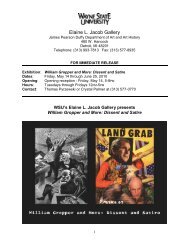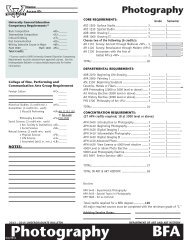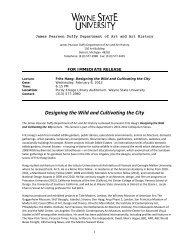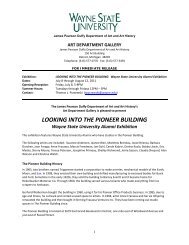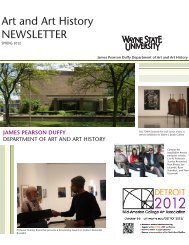linked - Department of Art and Art History - Wayne State University
linked - Department of Art and Art History - Wayne State University
linked - Department of Art and Art History - Wayne State University
Create successful ePaper yourself
Turn your PDF publications into a flip-book with our unique Google optimized e-Paper software.
Indeed, some historical periods <strong>of</strong> exceptional creative productivity can be <strong>linked</strong>, as Csikszentmihalyi<br />
notes <strong>of</strong> Renaissance Florence, to the intense involvement <strong>of</strong> an art patronage structure.<br />
“Working Around Paper”<br />
Danielle Aubert, <strong>Wayne</strong> <strong>State</strong> <strong>University</strong><br />
“Eros <strong>and</strong> Collaboration: Authorship in the Work <strong>of</strong> Three <strong>Art</strong>ist Couples”<br />
Hilary Harp, Arizona <strong>State</strong> <strong>University</strong><br />
“Bottom-up: <strong>Art</strong>ist Initiated Dialogical Methods for Ideation <strong>and</strong> Creation <strong>of</strong> Public<br />
Sculpture”<br />
Rod Northcutt, Miami <strong>University</strong> <strong>of</strong> Ohio<br />
“Deep Design: Designing Through Anthropological Immersion”<br />
Siobhan Gregory, <strong>Wayne</strong> <strong>State</strong> <strong>University</strong><br />
Digital Foundations: Merging New Media with <strong>Art</strong> School Traditions<br />
Thursday, October 4, 8:00 AM – 9:30 AM<br />
Founders B, Level Three, Westin Book Cadillac Hotel<br />
Chairs: Meg Mitchell, <strong>University</strong> <strong>of</strong> Wisconsin – Madison<br />
Digital Foundations is a growing trend in art schools across the country providing new opportunities<br />
to merge digital tools with traditional techniques in art education. Along with creating new<br />
educational opportunities this trend also presents new challenges in integrating hybrid art practice in<br />
institutions geared for traditional material <strong>and</strong> technique based curriculum. Creating a new<br />
discipline at a time when many art schools are headed in the direction <strong>of</strong> integrated or non-mediaspecific<br />
practice can be a challenge in itself not to mention finding space in already tight curriculum<br />
requirements for new foundations courses. Tension between the new <strong>and</strong> the traditional can be a<br />
major hurdle in terms <strong>of</strong> institutional practice <strong>and</strong> as a result educational institutions <strong>of</strong>ten play<br />
catch-up with practice in the field at large. Foundational education in digital tools <strong>and</strong> media<br />
literacy is therefore an important topic <strong>of</strong> discussion. The goal <strong>of</strong> the panel is to create discussion<br />
across a range <strong>of</strong> topics related to digital foundations in art schools.<br />
“True Mixed Bag: Great Successes <strong>and</strong> Stunning Failures with Digital Foundation Projects”<br />
David Richardson, Eastern Illinois <strong>University</strong><br />
“Creating with Code: Critical Thinking <strong>and</strong> Digital Foundations”<br />
Brad Tober, <strong>University</strong> <strong>of</strong> Illinois at Urbana – Champaign<br />
“Academic Graphic Design <strong>and</strong> Theme Based Curriculum”<br />
Blake J. Johnson, Saginaw Valley <strong>State</strong> <strong>University</strong>




